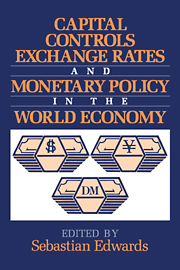Book contents
- Frontmatter
- Contents
- List of contributors
- Introduction
- Part I Monetary policy and stabilization in open economies
- Part II Capital mobility and macroeconomic policy in Europe
- 4 The lessons of European monetary and exchange rate experience
- 5 Experience with controls on international capital movements in OECD countries: solution or problem for monetary policy?
- 6 Real exchange rates and capital flows: EMS experiences
- 7 Monetary policy after German unification
- Part III Capital controls and macroeconomic policy in the Asia-Pacific region
- Part IV Capital mobility and exchange rates in Latin America
- Index
4 - The lessons of European monetary and exchange rate experience
Published online by Cambridge University Press: 16 October 2009
- Frontmatter
- Contents
- List of contributors
- Introduction
- Part I Monetary policy and stabilization in open economies
- Part II Capital mobility and macroeconomic policy in Europe
- 4 The lessons of European monetary and exchange rate experience
- 5 Experience with controls on international capital movements in OECD countries: solution or problem for monetary policy?
- 6 Real exchange rates and capital flows: EMS experiences
- 7 Monetary policy after German unification
- Part III Capital controls and macroeconomic policy in the Asia-Pacific region
- Part IV Capital mobility and exchange rates in Latin America
- Index
Summary
Seldom can the faults of a man-made system have been made as brutally clear as those of the European exchange rate mechanism (ERM) in the fall of 1992. For over a decade the ERM survived in a manner, defying gloomy predictions that its fate would be similar to that of the “Snake” in the 1970s, which disintegrated a few years after the collapse of Bretton Woods. The ERM survived even the abolition of exchange controls in 1990. But finally its luck ran out as it was hit by a series of large shocks – the weak U.S. economy producing a falling dollar, German reunification generating prolonged high German interest rates, and the even split of French opinion over the Maastricht draft treaty for a future EEC.
In this chapter I will try to explain why this has been a most damaging experiment in European monetary policy and has ultimately ended in predictable failure. I hope that I will be able to persuade monetary authorities to give a wide berth to policies based on fixed exchange rates, so perplexingly attractive to the elites of the non-German European continent; and that they will instead be tempted by the more robust Anglo-Saxon–German and now Japanese tradition of domestic monetary targeting within floating exchange rates.
The European monetary dilemma
The project to stabilize exchange rates in the European Economic Community (EEC) and ultimately to have a single currency has an obvious political motivation behind it.
- Type
- Chapter
- Information
- Publisher: Cambridge University PressPrint publication year: 1995



